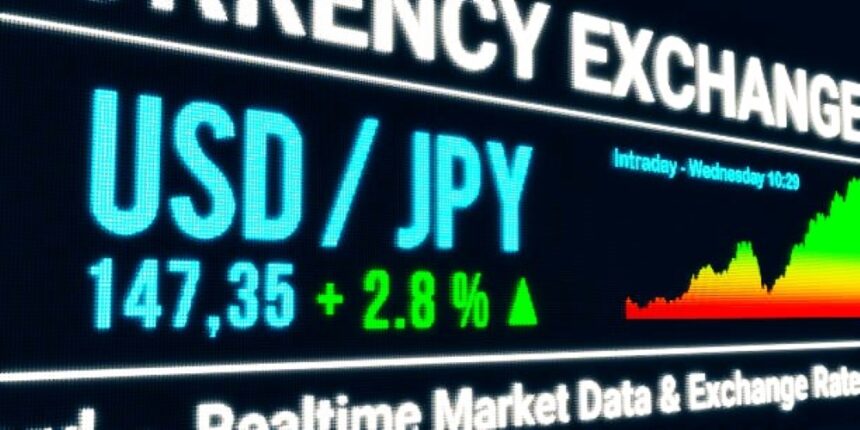Japanese Yen Weakens as Markets Digest BoJ Caution and Global Trade Risks.
The Japanese Yen (JPY) continued to lose ground against the US Dollar (USD) for the second consecutive session on Wednesday, slipping to a fresh weekly low during Asian trading. The USDJPY pair climbed toward the 144.30 mark, buoyed by modest US Dollar strength and a broadly risk-on sentiment that undermined demand for the safe-haven Japanese currency.
Market participants interpreted recent comments from Bank of Japan (BoJ) Governor Kazuo Ueda as a sign that the central bank remains cautious about aggressively raising interest rates. Despite improved domestic services data and persistent inflationary pressures in Japan, Ueda’s remarks highlighted uncertainties around global trade, prices, and growth—dampening expectations for near-term policy tightening and applying downward pressure on the Yen.
BoJ Governor Ueda Cools Immediate Hike Expectations
Speaking before Japan’s parliament on Tuesday, Governor Ueda emphasized that economic and price developments remain highly uncertain, especially in light of overseas trade policies. He reiterated that there is no preset timeline for rate hikes and underscored the BoJ’s data-dependent approach. His remarks came at a delicate time when markets were increasingly pricing in a rate hike in the second half of 2025.
Ueda’s cautious tone led traders to reassess the short-term policy path, despite growing pressure for the BoJ to normalize rates amid steadily rising wages and sticky inflation. The central bank had earlier taken a historic step by exiting its negative interest rate regime and scaling back bond purchases, fueling speculation that a new era of monetary tightening was underway. However, Ueda’s comments suggest the BoJ may opt for a slower pace.
Revised Services PMI Bolsters Long-Term BoJ Outlook
Despite the dovish central bank commentary, fresh macroeconomic data lent some support to the JPY. The final au Jibun Bank Services PMI for May was revised higher to 51.0, up from the preliminary 50.8 reading. Although it marked a slowdown from April’s 52.4, the figure still indicates expansion and points to ongoing resilience in Japan’s services sector.
Combined with signs of rising wages and persistent core inflation, this data reinforces the narrative that the BoJ may eventually need to tighten policy further—albeit not immediately. For now, however, the market appears to be focusing more on the central bank’s reticence rather than the medium-term economic outlook.
Snap Election Risks Add Political Uncertainty
Another factor weighing on the Yen is emerging political uncertainty. Reports surfaced this week that Japanese Prime Minister Shigeru Ishiba could dissolve parliament for a snap general election if the main opposition party follows through on its threat to file a no-confidence motion. This political backdrop adds another layer of unpredictability, potentially disrupting policymaking and weighing on investor confidence in the short term.
Uncertainty around the domestic political landscape may also further delay BoJ policy action, as central banks tend to avoid tightening during periods of political instability.
USD Supported by Job Market Data but Capped by Fed Outlook
On the other side of the USD/JPY equation, the US Dollar remains supported by solid labor market data, even as expectations mount that the Federal Reserve will cut interest rates in the latter half of 2025. Tuesday’s JOLTS report showed job openings rose to 7.39 million in April—exceeding market expectations of 7.1 million and the March figure of 7.2 million. This suggests continued tightness in the labor market and a still-resilient US economy.
Yet, the Dollar’s gains have been modest, as traders look beyond headline labor data to focus on broader macro trends. Market consensus now leans toward at least two 25-basis-point rate cuts from the Fed by year-end, a view supported by recent dovish rhetoric from Fed officials and a cooling trend in US inflation metrics.
Fiscal Fears and Tariff Troubles Weigh on Greenback
Beyond monetary policy, the US Dollar also faces headwinds from domestic fiscal concerns and rising trade tensions. The Biden administration’s decision to raise steel and aluminum tariffs from 25% to 50%, effective Wednesday, has revived fears of retaliatory measures from trading partners, particularly China.
White House officials confirmed that President Trump and Chinese President Xi Jinping are scheduled to speak on Friday—a conversation that could be pivotal for US-China relations. Traders are eyeing this call for signs of either escalation or de-escalation in the ongoing trade dispute. A hawkish tone from either side could rattle markets and reinvigorate safe-haven demand for the Yen.
Meanwhile, ballooning US fiscal deficits are increasingly being scrutinized. Analysts warn that the combination of expansive fiscal policy and slowing growth could exacerbate debt sustainability concerns. Should investors begin demanding higher returns to hold US Treasuries, it could trigger a rise in yields and complicate the Fed’s easing plans.
BoJ-Fed Divergence Sets Stage for Volatile Japanese yen Swings
The contrasting outlooks for monetary policy in Japan and the US are becoming more pronounced. While the BoJ is cautiously signaling future tightening, the Fed appears to be tilting dovish amid softening inflation and global risks. This divergence limits the USD’s upside and offers potential support to the JPY, especially if risk sentiment sours or geopolitical tensions flare up.
Safe-haven flows could return quickly in the event of a negative trade development or political shock—making the JPY an attractive hedge. That said, as long as the Fed-BoJ policy gap remains wide, the Dollar may continue to attract capital inflows on a relative basis.
Upcoming US Data to Set the Tone
Looking ahead, traders are focused on Wednesday’s ADP employment report and ISM Services PMI—both seen as precursors to Friday’s crucial Nonfarm Payrolls (NFP) report. Any signs of labor market weakness or slowing service-sector activity could reinforce expectations of Fed rate cuts and put downward pressure on the USD.
Conversely, stronger-than-expected data could revive speculation that the Fed may delay easing, providing fresh fuel for USDJPY upside. Markets are thus likely to remain volatile in the near term, driven by macroeconomic releases, Fed commentary, and geopolitical developments.
Technical Outlook: Japanese yen Eyes Key Resistance Near 144.50
From a technical standpoint, the USDJPY pair continues to exhibit a bullish bias. The latest rebound has taken the pair toward the 144.30 level, with resistance likely near 144.50—a zone that could attract selling interest if risk aversion returns. A breakout above this level could open the door for a run toward 145.00 or higher.
On the downside, immediate support lies at 143.60, followed by the 100-period EMA near 143.00. A sustained move below these levels would suggest fading bullish momentum and could push the pair back toward 142.50 or even the 141.80 zone.
Momentum indicators like the RSI and MACD remain in neutral-to-bullish territory, suggesting scope for further upside—though overbought conditions could limit gains in the absence of strong catalysts.
Conclusion: Japanese Yen Slips but Long-Term Tailwinds Remain
The Japanese Yen’s decline this week reflects a short-term shift in sentiment as markets react to dovish signals from the BoJ and moderately upbeat risk appetite. Yet, underlying fundamentals—including solid domestic data, rising inflation, and geopolitical risks—continue to argue for medium-term JPY resilience.
With the Fed widely expected to ease policy later this year, and the BoJ on a gradual tightening path, the diverging interest rate trajectories could eventually cap USDJPY gains and reignite demand for the Yen—especially if political and trade uncertainties deepen.
Investors should brace for further volatility in the days ahead, particularly as critical US data and a potentially pivotal US-China call come into focus. For now, the balance of risks suggests that while the USDJPY may grind higher in the short run, the Yen could stage a comeback if safe-haven demand returns or BoJ rate hike bets intensify.









